3.1 Medical Gas Therapy/Devices
Oxygen Masks and Devices Categories
The delivery of gasses, including oxygen, is a fundamental part of the life and work of the respiratory therapist. There are several types of oxygen masks and device categories. Low flow devices do not meet the patient's inspiratory flow needs. The patient supplements the oxygen flow by inhaling room air in addition to the delivered oxygen when using a low-flow O2 device. High flow devices meet or exceed the patient's inspiratory demands and deliver precise oxygen percentages. Reservoir devices deliver a higher concentration of oxygen during the inspiratory phase of the patient's breath.
NASAL CANNULA (Low Flow)
A nasal cannula is the simplest oxygenation device and consists of oxygen tubing connected to two short prongs that are inserted into the patient’s nares (see Figure 15[1]). The tubing is connected to the flow meter of the oxygen supply source. To prevent drying out the patient’s mucus membranes, bubble humidification may be added for hospitalized patients receiving oxygen flow rates greater than 4 L/min or for those receiving oxygen therapy for longer periods of time.[2]
Nasal cannulas are the most common type of oxygen equipment. They are used for short- and long-term therapy (i.e., COPD patients) and are best used with stable patients who require low amounts of oxygen. Nasal cannulas should be positioned with the prongs facing downward, following the natural shape of the nares, and the thinner tubing should be secured behind the patient’s ears.
Flow Rate: Nasal cannulas can have a flow rate ranging from 1 to 6 liters per minute (L/min), with a 4% increase from 20 in FiO2 for every liter of oxygen, resulting in a range of fraction of inspired oxygen (FiO2) levels of 24–44%.
Advantages: Nasal cannulas are easy to use, inexpensive, and disposable. They are convenient because the patient can talk and eat while receiving oxygen.
Limitations: The nasal prongs of nasal cannula are easily dislodged, especially when the patient is sleeping. The tubing placed on the face can cause skin breakdown in the nose and above the ears, so the respiratory therapist and other health care providers must vigilantly monitor these areas. Based on policy, the respiratory therapist and other health care providers should add padding to the oxygen tubing as needed to avoid skin breakdown and may apply a water-based lubricant to prevent drying. However, petroleum-based lubricant should not be used due to the risk of flammability and the risk of a lipoid pneumonia. Nasal cannulas are not as effective if the patient is a mouth-breather or has blocked nostrils, a deviated septum, or nasal polyps.[3]
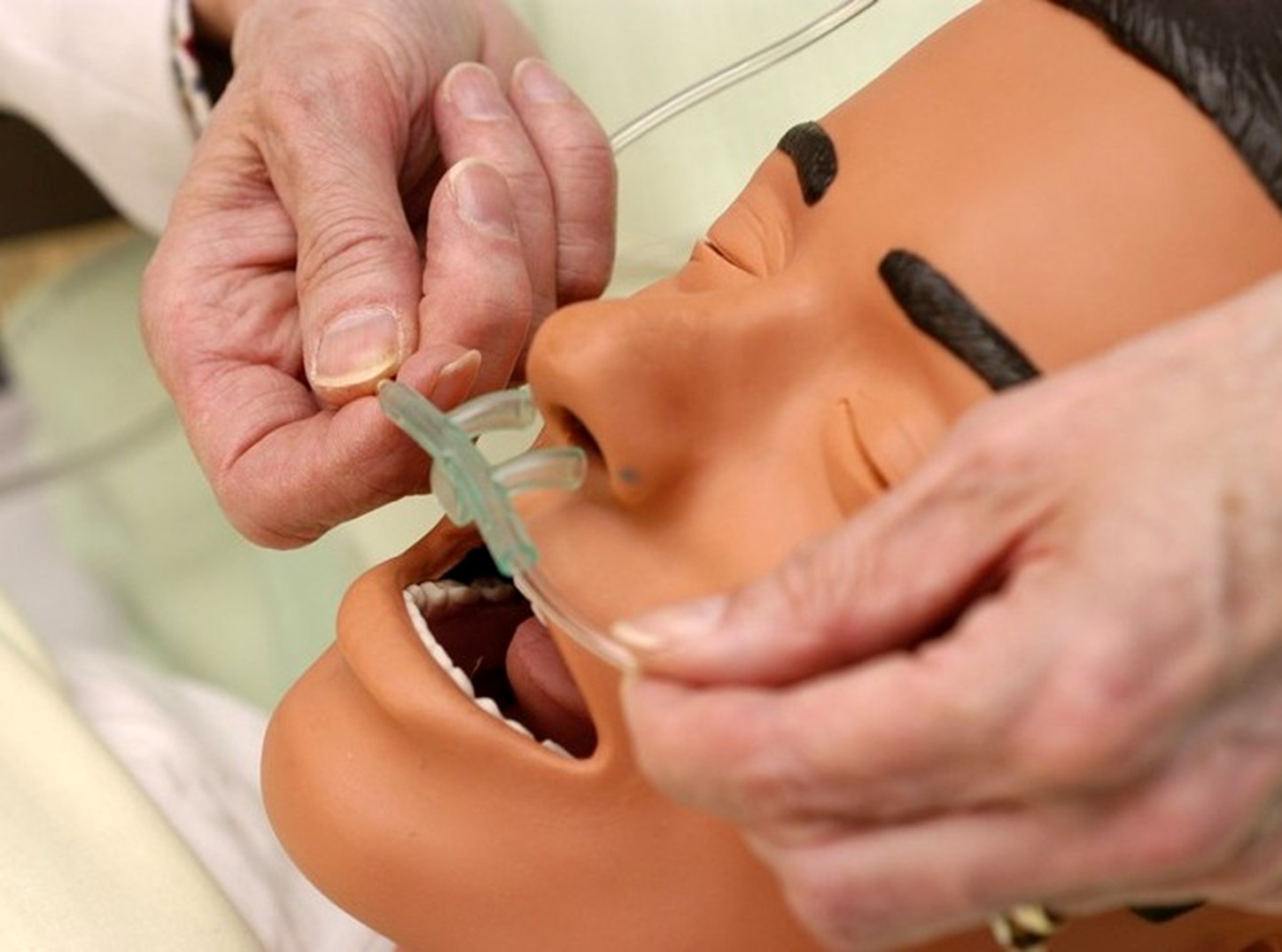
SIMPLE MASK (Low Flow)
A simple mask fits over the mouth and nose of the patient and contains exhalation ports (i.e., holes on the side of the mask) through which the patient exhales carbon dioxide. These holes should always remain open. The mask is held in place by an elastic band placed around the back of the head. It also has a metal piece near the top that can be pinched and shaped over the patient’s nose to create a better fit. Humidified air may be attached if the oxygen concentrations are drying for the patient. (See Figure 16.[4])
Flow Rate: Simple masks should be set to a flow rate of 5–10 L/min, resulting in oxygen concentration (FiO2) levels of 35–50%. The flow rate should never be set below 6 L/min because this can result in the patient rebreathing their exhaled carbon dioxide, which could lead to patient impairment or injury.
Advantages: Simple face masks are used to provide moderate oxygen concentrations. Their efficiency in oxygen delivery depends on how well the mask fits and the patient’s respiratory demands.
Disadvantages: Simple face masks must be removed when eating, and they may feel confining for some patients who feel claustrophobic while wearing the mask.
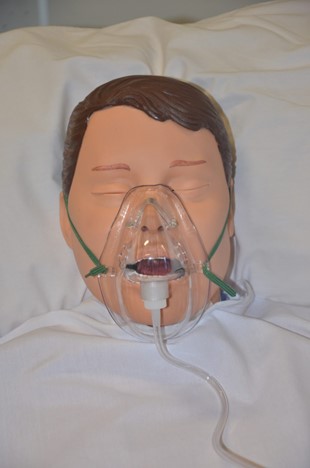
NON-REBREATHER MASK (Reservoir)
A non-rebreather mask consists of a mask attached to a reservoir bag that is attached with tubing to a flow meter (see Figure 17[5]). It has a series of one-way valves between the mask and the bag and also on the side of the mask that cover the exhalation ports, ensuring a high concentration of oxygen. The reservoir bag should remain 1/3 inflated during inhalation; if the bag deflates, there is a problem and immediate intervention is required. The one-way valves function so that on inspiration, the patient only breathes in from the reservoir bag; on exhalation, carbon dioxide is directed out through the exhalation ports. Non-rebreather masks are used for patients who can breathe on their own but require higher concentrations of oxygen to maintain satisfactory blood oxygenation levels. The non-rebreather is a high-flow mask system because it meets all the inspiratory needs of the patient. A nasal cannula, on the other hand, is a low-flow device because it does not meet all the inspiratory needs of the patient.
Flow Rate: The flow rate for a non-rebreather mask should be set to deliver a minimum of 10–15 L/min. The bag must not deflate during the patient’s inspiration. If it does, the flow should be adjusted to a higher flow. The flow can be adjusted higher than 15 L/min, and the standard outlet can reach 40 L/min. The reservoir bag should be inflated prior to placing the mask on the patient. With a good fit, the non-rebreather mask can deliver between 60% and 80% FiO2.
Advantages: Non-rebreather masks deliver high levels of oxygen noninvasively to patients who can otherwise breathe unassisted.
Disadvantages: Due to the one-way valves in non-rebreather masks, there is a high risk of suffocation if the gas flow is interrupted. The mask requires a tight seal and may feel hot and confining to the patient. It will interfere with talking, and the patient cannot eat while wearing the mask.
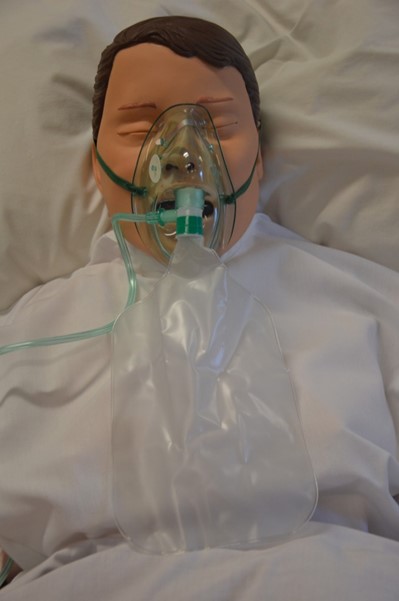
PARTIAL REBREATHER MASK (Reservoir)
The partial rebreather mask looks very similar to the non-rebreather mask. The difference between the masks is a partial rebreather mask contains one-way valves on each side of the mask, so the patient’s exhaled air does not mix with their inhaled air. A partial rebreather mask requires 10–15 L/min of oxygen but only delivers 35–50% FiO2.
VENTURI MASK (High Flow)
Venturi masks are indicated for patients who require a specific amount of supplemental oxygen to avoid complications, such as those with COPD. Different types of adapters are attached to a face mask that set the flow rate to achieve a specific FiO2, ranging from 24% to 60% (see Figure 18[6]). Venturi adapters are typically set up by a respiratory therapist as there are different oxygen concentration adaptors available (see Figure 19[7]).
A respiratory therapist should know the air/oxygen ratios when utilizing a Venturi mask or system.
| O2 Percentage | Air/O2 Ratio | The oxygen percentage can be calculated by using the following formula:
[latex]\frac {100-x}{x-21} = \frac {Parts of Air Entrainment}{1 part of O2}[/latex] Example for 40% FiO2 the Air/O2 ratio can be calculated: 100-40/40-21 = 60/20 = 3/1 or 3:1 |
|---|---|---|
| 60% | 1:1 | |
| 50% | 1.7:1 | |
| 40% | 3:1 | |
| 35% | 5:1 | |
| 24% | 25:1 |
Flow Rate: The flow rate depends on the adapter and does not correspond to the flow meter. Consult with a respiratory therapist before changing the flow rate.
Advantages: A precise amount of FiO2 is delivered to patients whose breathing status may be affected by high levels of oxygen. The benefit of using this device is that it is able to obtain an accurate FiO2.
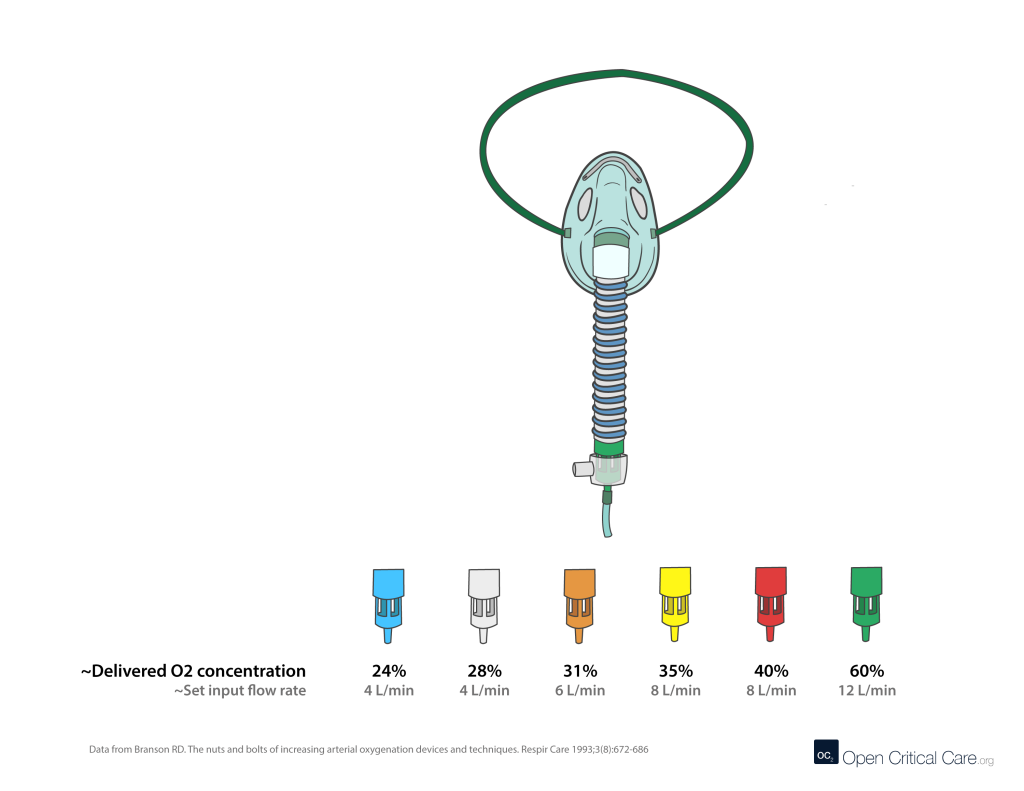
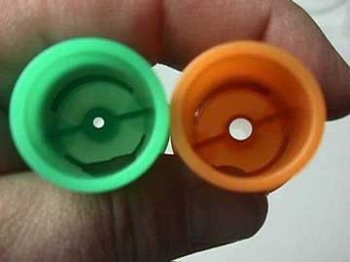
OXYMASK (Low Flow)
An OxyMask™ (see Figure 20[8]) is an oxygen delivery device that has an open design that eliminates the need for valves and reservoirs. O2 flow is directed towards the nose and mouth. Large openings in the mask allow CO2 to escape, decrease claustrophobia, increase the ability to communicate, and allow for delivery of fluids and medications without removing the mask.
Flow Rate: An OxyMask™ can deliver 24–90% oxygen concentration on 1–15 L/min oxygen, which increases flexibility and safety of the product.
Advantages: The OxyMask™ increases flexibility and safety due to variable oxygen flow rates. It also can decrease claustrophobia and increase the ability to communicate without removing the mask. Another advantage is the ability to perform oral suctioning with a Yankauer suctioning tip through the mask openings.
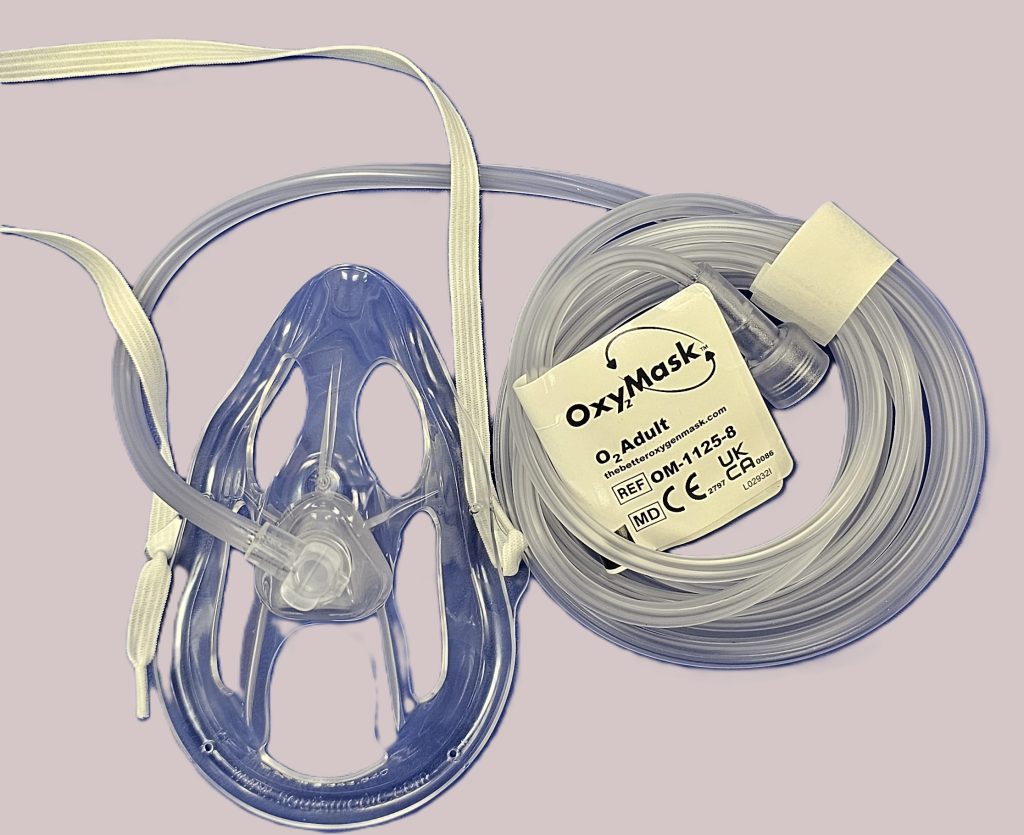
OXYMIZER (Reservoir)
An oxymizer (see Figure 21[9]) is a special nasal cannula that provides a larger luminal diameter in combination with an oxygen reservoir. The oxymizer is designed as either a mustache or pendant style. Some patients don’t like the weight of the device, which is greater due to the oxygen reservoir and tubing size.
Flow Rate: The flow rate is 1/4 to 1/2 of the set flow rate. The oxymizer can deliver up to 15 L/min.
Advantages: The oxymizer is able to help maintain adequate O2 saturations in hypoxic patients with a lower flow rate, resulting in reduced O2 costs, longer portable O2 sources, and decreased nasal irritation and dryness.
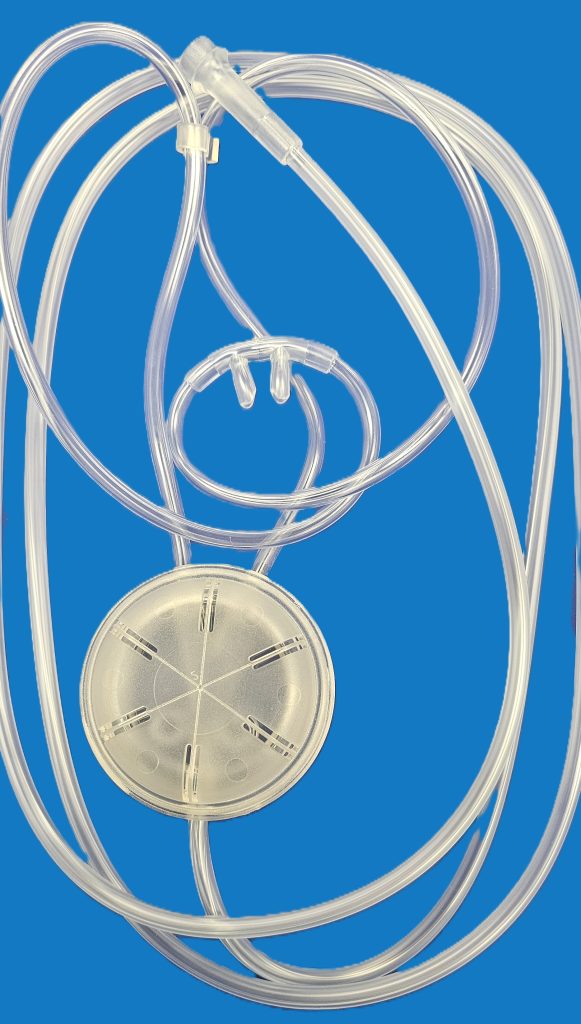
HEATED HIGH-FLOW NASAL CANNULA (High Flow)
High-flow nasal cannula (HFNC) therapy is an oxygen supply system capable of delivering up to 100% humidified and heated oxygen at a flow rate of up to 60 L/min (see Figure 22[10]). All settings are controlled independently, allowing for greater confidence in the delivery of supplemental oxygen, as well as better outcomes when used. In addition to greater control over the delivery of FiO2, there are several benefits to using a high-flow nasal cannula.
Flow Rate: The flow rate is up to 60–75 L/min depending on the device. The HFNC can deliver up to 95–100% FiO2 depending on the device.
Advantages: Many high-flow nasal cannula systems are designed with inline warming and humidification systems that provide appropriately humidified and body temperature air that is non-irritating to the mucosa, increasing patient comfort (31–37° C). Increased comfort leads to improved compliance and, therefore, better outcomes of therapy. Additionally, it can provide a small amount of “PEEP” by applying a splinting force to keep alveolar airways from collapsing under increased surface tensile stresses during exhalation. It is important to note that the patient needs to keep their mouth closed in order for this to be physiologically beneficial.
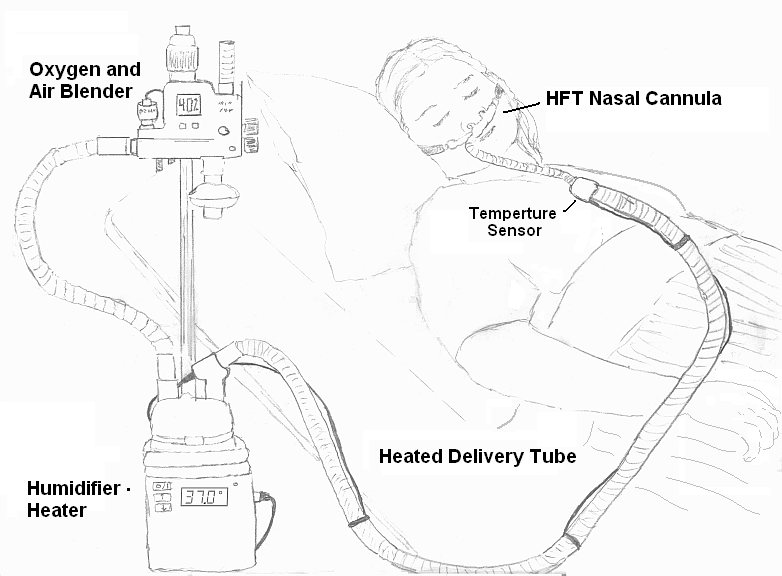
Humidity Concepts
An essential part of care of patients with bypassed airways due to artificial airway (i.e, endotracheal tubes, tracheostomies) is humidification. It is important to have an appreciation of the anatomical structures of the upper airway, and that understanding is essential to the application of humidification systems to our patients. Humidification can be heated or cooled.
There are several key concepts that a respiratory therapy student should understand regarding humidity.
Relative Humidity - The ratio of the moisture a gas is actually holding to what it can hold when saturated at a given temperature. This is represented by the following formula: absolute humidity (content) / moisture capacity (according to charts) x 100. This value is expressed as a percentage.
Absolute Humidity – The actual amount of moisture contained in a gas (i.e., content).
Body Humidity - The relative humidity of a gas at body temperature (37° C). This is represented by the following formula: absolute humidity (content) / moisture capacity at body temperature x 100. This value is expressed as a percentage.
Body Humidity Deficit – The difference between the capacity and the content of the gas being delivered to the patient.
| Temperature (°Celcius) | Vapor Pressure (mmHg) | Water Vapor Content (mg/L) |
|---|---|---|
| 20 | 17.50 | 17.30 |
| 21 | 18.62 | 18.35 |
| 22 | 19.80 | 19.42 |
| 23 | 21.10 | 20.58 |
| 24 | 22.40 | 21.78 |
| 25 | 23.80 | 23.04 |
| 26 | 25.20 | 24.36 |
| 27 | 26.70 | 25.75 |
| 28 | 28.30 | 27.22 |
| 29 | 30.00 | 28.75 |
| 30 | 31.80 | 30.35 |
| 31 | 33.70 | 32.01 |
| 32 | 35.70 | 33.76 |
| 33 | 37.70 | 35.61 |
| 34 | 39.30 | 37.57 |
| 35 | 42.20 | 39.60 |
| Figures calculated using the Clausius-Clapeyron equation.[11] | ||
- “Image00011.jpg” by British Columbia Institute of Technology is licensed under CC BY 4.0. Access for free at https://opentextbc.ca/clinicalskills/chapter/5-5-oxygen-therapy-systems/ ↵
- Ernstmeyer, K., & Christman, E. (Eds.). (2023). Nursing skills 2e. Open RN. https://wtcs.pressbooks.pub/nursingskills/ ↵
- Ernstmeyer, K., & Christman, E. (Eds.). (2023). Nursing skills 2e. Open RN. https://wtcs.pressbooks.pub/nursingskills/ ↵
- “DSC_2086.jpg” by British Columbia Institute of Technology is licensed under CC BY 4.0. Access for free at https://opentextbc.ca/clinicalskills/chapter/5-5-oxygen-therapy-systems/ ↵
- “DSC_2083.jpg” by British Columbia Institute of Technology is licensed under CC BY 4.0. Access for free at https://opentextbc.ca/clinicalskills/chapter/5-5-oxygen-therapy-systems/ ↵
- “Air-entrainment-delivery-device-mask-fn4yot.png” by Open Critical Care is licensed under CC BY-NC-SA 4.0 ↵
- “Entrainment ports” by Don Raymond, Chippewa Valley Technical College is licensed under CC BY-NC 4.0 ↵
- "oxymask" by Kirsten Holbrook, Chippewa Valley Technical College is licensed under CC BY-NC 4.0 ↵
- "oxymizer" by Kirsten Holbrook, Chippewa Valley Technical College is licensed under CC BY-NC 4.0 ↵
- “HFT diagram.png” by Strangecow is in the Public Domain. ↵
- Chung, P. & Censullo, A. (2025). Clausius-Clapeyron equation. Chemistry LibreTexts. https://chem.libretexts.org/Bookshelves/Physical_and_Theoretical_Chemistry_Textbook_Maps/Supplemental_Modules_(Physical_and_Theoretical_Chemistry)/Physical_Properties_of_Matter/States_of_Matter/Phase_Transitions/Clausius-Clapeyron_Equation ↵

